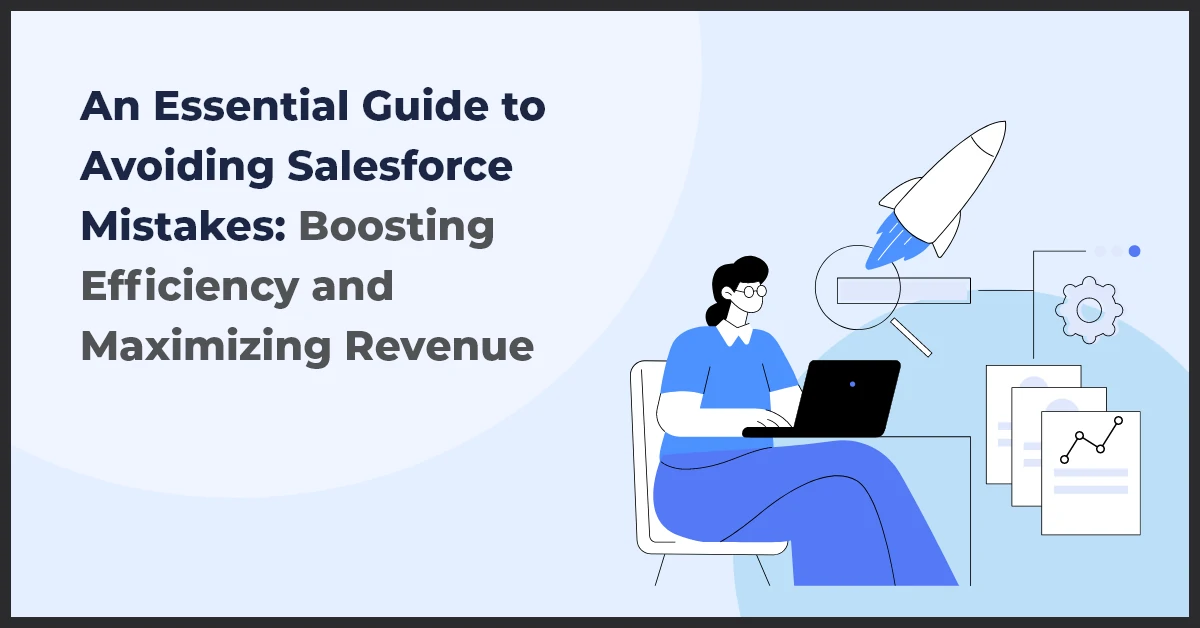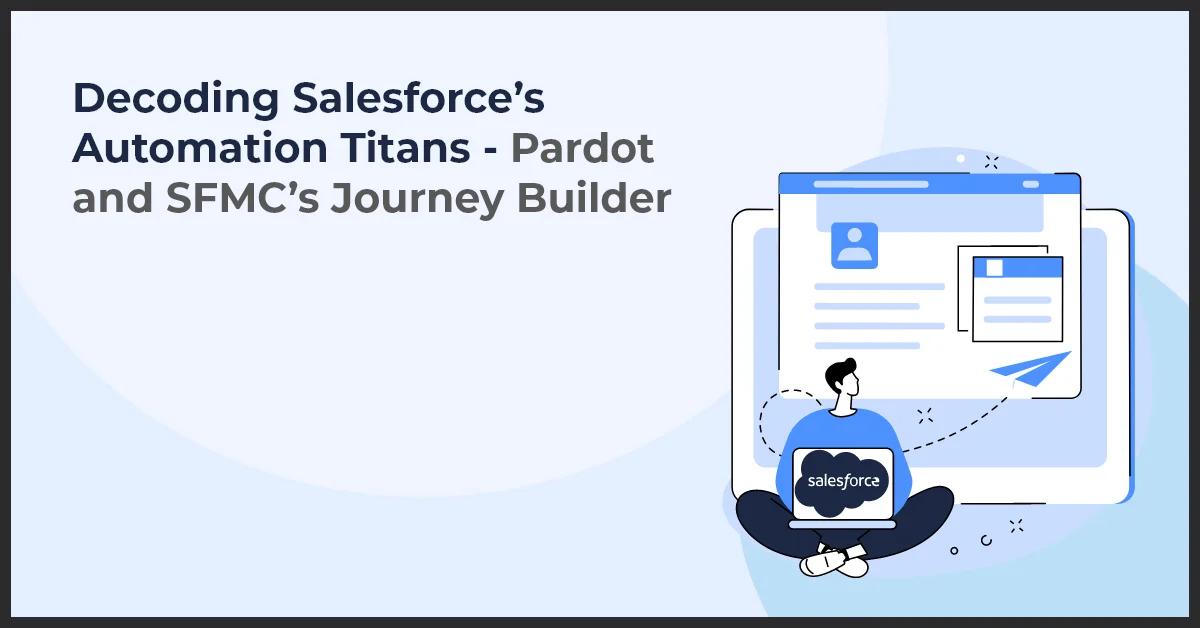An Essential Guide to Avoiding Salesforce Mistakes: Boosting Efficiency and Maximizing Revenue

Published on: November 8, 2023
Updated on: March 21, 2024
540 Views
- Salesforce
6 min read
Are you a business owner or manager looking to streamline your sales processes and maximize revenue through Salesforce? It's crucial to understand the concept of Salesforce mistakes and their impact on businesses. Salesforce mistakes refer to common errors or oversights in the implementation and management of this powerful customer relationship management (CRM) platform. These mistakes can lead to lost opportunities, decreased productivity, and even damage to your business reputation.
Avoiding these common errors is of utmost importance for successful Salesforce implementation and management. By understanding and learning from the most common Salesforce mistakes, you can ensure efficiency, accuracy, and smooth operation. In this comprehensive guide, we will explore the importance of avoiding these mistakes and provide valuable insights and strategies to help you make the most out of Salesforce and drive your business towards unmatched success.
Common Mistakes in Salesforce Implementation
Lack of Proper Planning and Strategy
When implementing Salesforce, it is essential to have a solid plan and strategy in place. Unfortunately, many organizations make common mistakes in this area:
- Neglecting to define clear objectives and goals for Salesforce implementation can lead to confusion and inefficiencies within the system.
- Failing to align Salesforce with business processes and requirements can result in a system that does not meet the needs of the organization.
- Not involving key stakeholders and end-users in the planning phase can lead to resistance and lack of adoption when the system is implemented.
Insufficient User Training and Adoption
Proper training and user adoption are crucial for Salesforce implementation success. Common mistakes in this area include:
- Inadequate training for Salesforce users can lead to low system adoption and a lack of understanding of how to effectively use the platform.
- Lack of user awareness about available features and functionality can result in underutilization of Salesforce and missed opportunities for process improvement.
- Failure to provide ongoing training and support to Salesforce users can hinder their ability to fully leverage the system and hinder overall success.
Poor Data Quality and Management
Data plays a vital role in Salesforce implementation. However, organizations often make mistakes when it comes to data quality and management:
- Neglecting data cleansing and deduplication processes before migration can result in data integrity issues and duplicate records within Salesforce.
- Inadequate data integration can lead to incomplete or inaccurate information in the system, hindering its usability and effectiveness.
- Not establishing proper data governance practices can result in data inconsistencies and difficulties in maintaining data quality over time.
Inadequate Customization and Configuration
Customization and configuration are important aspects of Salesforce implementation. However, organizations often make mistakes in this area:
- Overcomplicating Salesforce customization without considering user experience can lead to confusion and frustration among users.
- Ignoring best practices for custom object creation, fields, and validation rules can result in a system that is difficult to maintain and troubleshoot.
- Failing to implement automation workflows and processes effectively can hinder efficiency and productivity within the system.
Common Mistakes in Salesforce Management
A successful implementation of Salesforce is just the beginning. Proper management is equally important to ensure the platform runs smoothly and serves its purpose effectively. However, there are several common mistakes that organizations make in managing Salesforce.
A. Errors in Configuring Reports and Dashboards
- 1. Misaligned report criteria leading to incorrect data representation: Incorrectly configuring report criteria can result in inaccurate data analysis and misinterpretation of insights.
- 2. Inadequate report and dashboard sharing permissions causing data visibility issues: Improperly setting sharing permissions can limit or grant unauthorized access to important reports and dashboards, compromising data security.
- 3. Choosing inappropriate report types for required insights: Selecting the wrong report type can lead to irrelevant data visualizations, hindering effective decision-making.
B. Challenges in User Permissions and Access Control
- 1. Granting excessive or incorrect user permissions compromising data security: Providing users with unnecessary or incorrect permissions can expose sensitive data to unauthorized individuals.
- 2. Inefficient management of user roles and profiles: Poorly managing user roles and profiles can result in users having unnecessary access or missing out on essential functionalities.
- 3. Failing to revoke system access for former employees or partners: Neglecting to remove system access for individuals who are no longer associated with the organization can pose a security risk.
C. Issues in Managing Campaigns and Lead Scoring
- 1. Inconsistent campaign tracking resulting in inaccurate lead attribution: Inaccurate tracking of campaigns can lead to improper attribution of leads, impacting the effectiveness of marketing efforts.
- 2. Lack of lead scoring methodology impacting lead qualification and nurturing: Without a proper lead scoring methodology, sales teams may waste time on unqualified leads, affecting overall efficiency.
- 3. Insufficient integration between sales and marketing processes: Poor integration between sales and marketing can result in misalignment and missed opportunities for lead conversion.
D. Troubleshooting and Support Pitfalls
- 1. Inefficient knowledge base and documentation for self-help: Lacking comprehensive self-help resources can slow down issue resolution and frustrate users.
- 2. Delayed or improper response to user queries and support tickets: Failing to provide timely and accurate support can lead to user dissatisfaction and hinder productivity.
- 3. Failure to conduct regular system checks and maintenance: Neglecting routine system checks and maintenance can result in performance issues and system downtime.
Conclusion
Learning from common Salesforce mistakes and implementing effective strategies is crucial for successful Salesforce implementation and management. By being aware of these mistakes, businesses can avoid common pitfalls and optimize their use of Salesforce.
Tips for Avoiding Common Pitfalls
- Invest in comprehensive Salesforce training for employees to ensure they have a solid understanding of the platform and its features.
- Regularly update and maintain Salesforce to take advantage of new features and improvements.
- Establish clear communication channels and processes to avoid miscommunication and confusion within the team.
- Regularly review and analyze data to identify areas for improvement and make informed business decisions.
- Seek feedback from users to continually optimize the user experience and address any pain points or challenges.
Resources for Enhancing Salesforce Implementation and Management Knowledge
- Join Salesforce communities and forums to connect with other users, learn best practices, and get support from the Salesforce community.
- Take advantage of Salesforce Trailhead, a free online learning platform that offers interactive, self-paced courses on various Salesforce topics.
- Attend Salesforce events, webinars, and workshops to learn from industry experts and gain valuable insights and tips for successful implementation and management.
- Engage with Salesforce consultants or experts to get tailored advice and guidance for your specific business needs.
By implementing these tips and utilizing the available resources, businesses can maximize the potential of Salesforce and avoid common pitfalls, leading to improved efficiency, productivity, and overall success.



